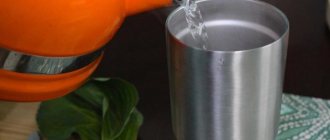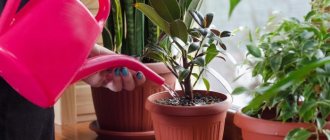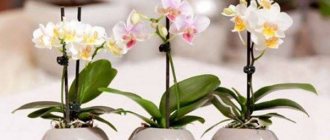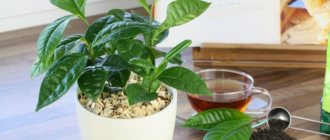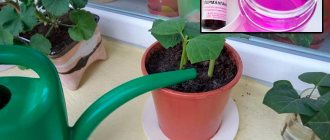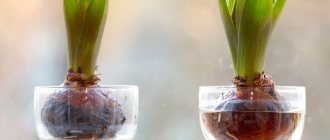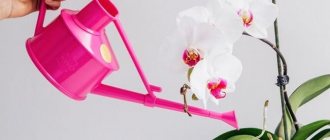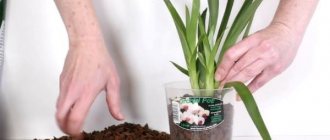Which plants are allowed and which are not?
Only a small number of indoor pets like to occasionally treat themselves to water with minerals dissolved in it.
These include cacti, which are accustomed to living and developing in desert conditions with a hot, arid climate.
To form strong needles and spines, shell rock, eggshells or chalk are added to the soil for cacti, so if the water is too soft, you can sometimes water the cactus with mineral water, this will be beneficial for its health.
A one-time watering with mineral water has a good effect on begonias , the leaves become shiny and the plant is abundantly covered with buds, but this can be done no more than once every two months.
There are flowers on the windowsills of amateur flower growers that cannot be watered with mineral water at all! Never and under no circumstances. These flowers include orchids.
In nature, these tropical plants are epiphytes, that is, they grow on other plants, but do not parasitize them, but receive moisture from the air and precipitation.
This video will tell you about watering indoor plants with mineral water:
Harm of watering with mineral water
When asking whether it is possible to water flowers with mineral water, one should not lose sight of the possible negative consequences of such a procedure for indoor “pets”. The composition of each type of liquid may differ in the concentration of substances it contains. At the same time, it is not possible to make an exact calculation for indoor plants, since mineral water is not designed for such procedures.
Some owners of indoor plants are of the opinion that mineral liquid can be an excellent source of fertilizer. However, we should not forget that the modern horticultural market offers a wide range of ready-made formulations that contain all the necessary components for growth and development in the required concentration. In addition, the use of such fertilizers will be many times cheaper and safer than home experiments.
Flower growers consider ordinary tap water, previously kept at room temperature for 24 hours, to be a good alternative to mineral water.
Main settings
It is logical to assume that the requirements for water used for watering indoor plants are much more serious. It should be soft and slightly acidic, contain oxygen, macro- and microelements. There is a concept of hardness, which in everyday life usually means the concentration of magnesium and calcium ions. Of course, it is better to water the plants with salt-free water. It is known that boiling slightly reduces the concentration of harmful substances. Therefore, the question arises as to whether it is possible to water flowers with boiled water.
Whey is very beneficial for plant growth. It saturates the root system with useful organic and mineral substances. If the roots receive good nutrition, then the above-ground part of the bushes will be healthy.
Irrigation with serum is an indispensable and effective prevention against fungal infectious diseases. The product works no worse than special fungicide preparations designed to combat pests and diseases.
Note! Do not water indoor plants with undiluted serum in its pure form. Otherwise, burns will appear on the leaf plates. The product is dissolved in water in a ratio of 3:1.
Tea is good for plants
The consequences of watering indoor plants with mineral water
When deciding to use store-bought liquid to irrigate home flowers, it is important to consider what will happen if you water the flowers with mineral water. The main disadvantage of its composition is the presence of a large amount of salts that settle on the soil surface. Over time, this will be noticeable as a white residue on the soil in the pot. In addition, salt deposits easily penetrate into the depths of the earthen clod, reaching the roots of any plant.
Salting the soil in a pot like this can lead to the following negative results:
- Oversaturation of the soil with microelements, which will inhibit the proper development of the plant and inhibit its growth.
- A large amount of salts and alkali remaining on the surface of the earth can lead to the death of an indoor flower.
- The soil acquires a rigid structure, preventing the roots of the plant from being saturated with oxygen from the air.
Whether it is possible to water plants with mineral water is up to each gardener to decide for himself, but it is important to consider that some varieties cannot tolerate this type of “care” at all. In addition, the consequences of watering can do more harm than good.
What kind of water is better to use?
Water for watering indoor flowers should be soft, that is, contain a small amount of salts, do not contain chlorine and carbon dioxide, and be moderately warm.
Three types of water are ideal for watering indoor pets:
- river;
- rain;
- melting from the snow.
If it is not possible to use one of these three types, then you can soften ordinary water from your home tap.
For maximum benefit, you need to let it sit on the table for 24 hours and, if possible, acidify it, add a couple of handfuls of peat chips or a teaspoon of citric acid per ten liters.
Flowers do not like cold water; they need to be sprayed and watered with liquid warmed to room temperature .
All the most important and useful information about mineral water can be found in this section.
Is it possible to water flowers with tea leaves and tea?
Chemical analysis of tea shows: tannins, potassium, manganese, iron.
The debate among forum members about the benefits of tea leaves as a means of fertilizer does not subside.
- the acidity of the substrate increases;
- air penetrates better into the soil;
- compost is activated;
- clay soils are loosened;
- Mulching retains moisture.
- flower growers have a sufficient selection of universal fertilizers to use dubious ones;
- scented additives upset the soil balance;
- the sweet drink breeds pests: fungus gnats, midges;
- moldy tea leaves introduce bacteria and fungi into the ground;
- the soil turns sour.
Good to know! Soil acidification is determined by a green coating with an unpleasant odor and mold on the stems. They take measures: saturate the soil with oxygen, loosen it, and do not allow water to stagnate in the pots.
When going on vacation, the indoor greenhouse is left on automatic watering. Use: plastic bottles, capillary mats, wick irrigation, ceramic cones.
The health of pets in a home greenhouse depends on watering. Use soft, settled liquid at room temperature. They don’t use aquarium water very often, the whey is diluted, and they don’t get carried away with tea leaves. It is prohibited to use beer with preservatives, distilled water, from a well, lake, or air conditioner. Gases are released from mineral water.
What happens if you water with mineral water?
This question cannot be answered with a clear yes or no .
It is useful for some, but in small quantities and not often, for others it is strictly contraindicated. It all depends on the area where the flower grows in the wild.
In the tropics, many flowers grow in a humid tropical climate, literally in limbo, fed by rainwater, which is soft and contains a minimal amount of mineral salts.
Such plants, even in indoor conditions, need only purified and settled moisture, without additional mineralization. Representatives of desert flora are content with poor, saline soil with insufficient moisture and containing many dissolved minerals. Such plants are accustomed to drinking water with mineral impurities.
They can be watered moderately with mineral water in order to saturate the soil with a small amount of salts, but not more than once a month.
Seated, without gas
Mineral water can be used for watering plants only after long-term settling. The mineral water in an open wide container is left to stand on the table for a day to allow the carbon dioxide bubbles to evaporate and become saturated with oxygen.
If you use mineral water for irrigation, you should choose “table” brands from the wide range on sale, since they contain minerals in small quantities.
“Healing” waters, oversaturated with elements of the periodic table, can cause irreparable damage to pets.
With gas
It is strictly forbidden to water plants with liquid containing carbon dioxide dissolved in it; this can lead to dangerous consequences for the flower. Bubbles of carbon dioxide get along with water to the roots of plants, depress them and interfere with respiration.
How does rainwater affect growth?
Experts consider using rainwater to water plants to be the best choice. It is often equated to melt water. The watering liquid in both cases has a degree of softness that is ideal for indoor flowers.
We recommend: How to care for philodendron at home
However, residents of large cities are wary of this possibility due to the large amount of harmful impurities in the air. Experts advise collecting rainwater when it has been raining for several days in a row. In this case, its quality will be higher.
Frequently asked questions: About watering
1. What kind of water should I use? How to soften water? By available means? Can it be boiled? Who uses filters, is there any benefit?
Answer:
You can filter water with a filter containing ion exchange resins or osmotic membranes, the result is excellent. But the process is long, and when you need to filter 15-20 liters in order to water all the flowers, it is simply painful. Plus, you regularly need to buy new filter cassettes, which, with intensive use, become clogged within a month or a month and a half.
Boiling water is also effective and also a chore. In addition, when boiling, air is removed from the water, which is not good for plants (the amount of dissolved oxygen is so small that it has no effect on the plant, unless, of course, it is flooded). It’s good to water with snow water, although, of course, it’s also a chore: the volume of snow is large, but you don’t get enough water. In addition, in the city a lot of smoke and dirt settles on the snow; it is better to collect it in the forest away from the highways, which in itself is not always feasible.
In stores you can find a “decalcifier,” that is, “a special product for neutralizing water hardness.” As they write in the annotation, “binds calcium and magnesium salts (causing water hardness), softening water for watering plants.” 500 ml – 85 rub. Most likely this is a solution of sodium salt EDTA, in any case, in the household you can use EDTA (Trilon B) as an anti-scale agent, but calcium dissolves and becomes a complex, but does not disappear.
About watering with cold “hot water”. Softeners and inhibitors are indeed often added to hot water from thermal power plants and boiler houses. However, this water circulates in a closed cycle and does not enter the water supply system. Through a heat exchanger, it heats ordinary cold tap water, which flows from the tap hot. Those. Hot tap water has the same chemical composition as cold water. But there are two differences.
First: hot tap water is most often softer and contains fewer dissolved gases, since the solubility of hardness salts and gases decreases with increasing temperature.
Second: the solubility of everything else increases with increasing temperature. So if the hot water supply system is very old or, on the contrary, completely new, then the hot water may be more “rusty” because it will dissolve iron salts that are present in old and completely new pipes. In addition, hot water can sometimes have an unpleasant taste, which it gets from plastic and rubber parts of the plumbing system (this almost never happens in residential buildings). This taste does not affect the chemical composition of the water in any way.
Conclusion: in the vast majority of cases, if you live in a normal residential building and your hot water is not rusty, it is better to settle it for irrigation. The taste, if there is one, can be ignored.
Freezing water in the freezer can only give a positive result in softening the water if it is frozen correctly. If you simply freeze water, then all the salts are included in the ice, and when it thaws, they return to the water. To obtain melt water, you must first monitor the process by freezing the water. Water does not freeze immediately; a certain amount of water remains, which then also freezes, but it is this water that does not immediately freeze that is a saturated saline solution, which has a lower freezing point. If you have time to drain this unfrozen solution, then the melted ice will produce melted, soft water. Otherwise, freezing makes no sense. Another thing is that there are different cities and the ecology too. If someone’s municipal water supply system is doing a bad job, then there’s no point in arguing, it will be pointless. And hot water is not chlorinated. This is pointless, because... it undergoes intensive boiling in boiler rooms, on the walls of which, by the way, harmful magnesium and calcium salts remain.
The only reliable means of softening cold water is the addition of oxalic and some other acids to control acidity. But you still need to protect it from chlorine.
2. Can you really water flowers with mineral water? it contains minerals needed by flowers, but in smaller quantities than in mineral fertilizers, in addition, it contains oxygen.
Answer:
Firstly, where does the oxygen come from? There is carbon dioxide there, but there is hardly more oxygen than in ordinary water.
And most importantly, the composition of mineral (not drinking, but medicinal mineral) waters is very different. There are ferruginous waters, and there are sulfurous ones. And plants need a certain balance of microelements. It is micro, since there is not enough nitrogen and phosphorus in the mineral water, this is not slurry.
Secondly: why? There are many fertilizers for indoor plants on sale. There are microelement complexes, for example, “Cocktail”. Why reinvent the wheel? There will be no savings from this either: by diluting liquid fertilizer, we will get much more solution than you can buy mineral water with this money. What's the point?
This is entertainment for the lazy. Poor tap water is indeed a problem, but then you need to water it not with mineral water, but with drinking water. For example, the one sold in five-liter plastic bottles. Or the one in 20-liter bottles for office drinkers (this is really soft water, since the method of ion exchange resins or osmosis is used for purification).
3. How to acidify water?
Answer:
You can acidify with citric acid, i.e. it gives an effect. Here is a person with 15 years (!) of experience in growing bonsai directly advises: “3-4g per 10 liters, or, if funds allow, ascorbic acid.” https://www.bonsai.ru/agro/nachalo.html Whether acidification is NEEDED depends on the species characteristics of the plant; some need it, others don't. For example, many orchids need this.
4. Do plants need iron?
Answer:
Everyone needs iron, like other microelements, copper, cobalt, molybdenum, zinc. Moreover, iron can exist in different forms, divalent and trivalent. Plants for the most part need divalent. You can see more details at https://www.msaqua.com/pmdd/iron.htm
5. Is it possible or not to water plants with boiled water?
Answer:
We need to look at what will cause more harm to this particular plant growing in this particular pot in this particular soil - from watering with unboiled water (hard, chlorinated, etc.), or from watering with boiled water (no air, hardness decreases, but maybe not completely, etc.). There are plants that are very sensitive to calcium salts. On the contrary, there are plants that love calcium. There are other plants. There are other methods of softening water. In general, how is hard water harmful? Because the soil quickly becomes salty. The same result can be “achieved” by too much inept and frequent feeding. Each gardener has his own opinion on this matter, due to the fact that he has more access. You need to watch how the plant reacts and act accordingly.
Is it possible to water indoor flowers with serum?
People are returning to nature, everything natural: fabrics, food, drinks. This slogan was transferred to home flora. Now the question is no longer which liquid to choose for irrigation. They take natural products, without pesticides and chemicals. Whey came under the gun. And for good reason.
The whey is acidic. Useful substances: amino acids, trace elements, phosphorus, potassium, lactic bacteria. An invaluable fertilizer and pest suppressant. An undiluted product will damage the flora and disrupt the soil balance. Suitable ten times mixed with liquid. This is the base solution.
- Add 0.5 kg of sugar per 10 liters and a pinch of yeast to the whey solution. Fill the cut grass.
- Dissolve iodine in diluted whey (10 drops per 10 l), add ash.
To water under the roots, dilute 1 part fertilizer in 10 parts of liquid. For spraying, take 1 liter of solution for 3 liters of water.
Important! In a dormant state, plants are not fed with whey.
Serum for watering a home greenhouse
